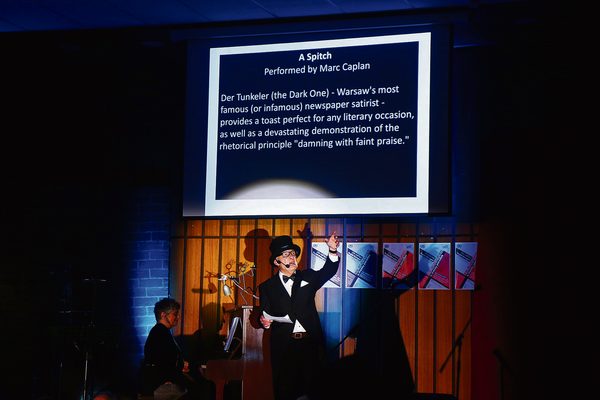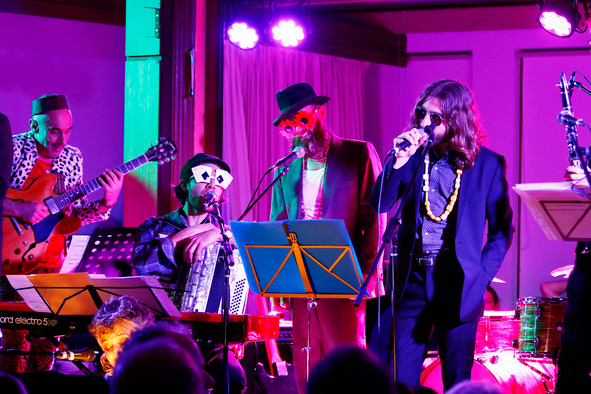During the COVID-19 lockdowns, more than 300,000 people signed up to learn Yiddish on Duolingo, that figure being equal to about half the total number of Yiddish speakers in the world today.
With the constant message that Yiddish is dying, young Jews in Melbourne are determined to prove this cliche wrong.
Organisations within the community are doing more and more to engage the youth in Yiddish language and culture, and with more and more young people beginning their own personal journeys with Yiddish there has been a surge in engagement coming from under 30s.
Yiddish language coordinator at The Kadimah Esther Singer said the young people starting to get into Yiddish generally fall into three groups.
There are those who are wanting to learn a bit more about a language that was a part of their family history.
“If they’re in their 20s, that was their grandparents’ language, and they feel that they haven’t had much opportunity to learn a lot about it,” Singer said.
She explained that another reason young people are interested in Yiddish is for the art.
“I would say some people come because they are really into literature. Some people are much more on the music side of things,” she said.\
“Politics be damned, Yiddish is lovely!”
Rounding out the reasons she has taken note of Singer said, “People who want to do something that’s more broadly to do with Jewish culture and history” often take up Yiddish.
She explained students in her Yiddish language classes at The Kadimah often share a common feeling, a “sense [that] something has been lost.”
Singer told The AJN that students “don’t need to be involved in other aspects of Jewish culture, but like any language, it reflects the culture that created it, and the people who created it”.
“I think young people are interested in Yiddish, it’s just a matter of making sure that they have the opportunity to do with Yiddish what they want, whether that’s learn more Yiddish, create Yiddish culture or meet with other Yiddish people,” she said.
Yiddish activist Doodie Ringelblum explained that potentially another reason young people are turning to Yiddish as their form of connection to their Jewishness is because Zionism has seen them excluded from the progressive spaces they want to occupy.
“Some people have been excluded by the broader university community, the broader left, and so have said, [Yiddish] is what we will turn to,” he said.
“For others, it’s a genuinely felt internal emotion, where they’re very conflicted by the romantic idealism and notion of Jewish statehood and Zionism and national liberation on the one hand, and the practical failings of it in the Middle East today.”
Ringelblum said there are of course plenty of young people who say, “Politics be damned, Yiddish is lovely!”
“It has a rich culture, it has a rich history, it has a rich language and literature and music. And in Melbourne, in particular, there are multiple ways and opportunities to connect with Yiddish. It’s incredibly dynamic,” he said.
For 28-year-old Hillel Kuttner, Yiddish “resonates a lot more with me”, he said, when compared with other forms of Jewish expression.
He started learning Yiddish in 2021 because he said it “makes me feel closer, I guess, to my family history”.
Kuttner is taking Yiddish lessons at The Kadimah, taught by Esther Singer, who he described as an incredible teacher.
He told The AJN that Yiddish is “a whole section of my identity”.
“If I’m going to speak a Jewish language, I’d rather speak Yiddish than Hebrew,” he said.
He explained that he related to songs in Yiddish and it is the “culture that I enjoy”.
“Knowing the language has made it a lot easier for me to read resources and listen to interviews, or find books and being able to understand them in the source language, helps with getting in touch with other people.”
A common thread between young people is the shared fear that the language will disappear.
Kuttner said, “It’s not spoken widely, and I’d rather not have it disappear altogether.”
Echoing these sentiments is Mia Borowitz, chairperson of the Sotsyalistishe Kinder Farband (SKIF) in Melbourne.
“Our people have experienced so much for us to come here, and for us to let go of this history, that would be a very sad thing.”
She said however, “It won’t happen because especially at SKIF, we are so determined to really instil a strong sense of Yiddishkeit in the kids.
“There’s this hunger to participate in the Yiddish community and it comes back to the idea of who will write our history. If not me, then who?”
Borowitz learnt Yiddish all through high school after falling in love with it at Sholem Aleichem College where she attended primary school.
She explained that after finishing at Sholem Aleichem there was an option to continue with her Yiddish studies. “For me, it wasn’t an ‘option’. It was like, absolutely,” she said.
Borowitz recognised that there is a gap for those who are at an intermediate Yiddish level and said there are plans in the works for them to maintain their grasp of the language.
She also emphasised that “the Jewish schools could play a role”, in bringing more young people into Yiddish and that the young people themselves need to be “taking this responsibility and saying, this is my culture, and I want to preserve it. Who’s going to be sitting at the table in 30 years?
“Our people have experienced so much for us to come here, and for us to let go of this history, that would be a very sad thing.”
“I’m going to spread the word and encourage people to engage in it. That’s my personal plan of action, and that’s what I think will work,” she said.
In her attempts to encourage others to take up Yiddish or get involved in Yiddish culture, Borowitz aims to “make Yiddish cool”.
A common theme among those who are already engaged in the Yiddish community is the importance of the vibrant Yiddish music scene in Melbourne.
Leader of Yiddish troupe YID! Simon Starr, who switches between guitar and drums, explained that the people dancing in the front row of YID! performances are young people aged between 15 to 19 years old.
“It’s exciting,” he told The AJN. “They obviously would go dancing to other stuff and see other bands, but they do it to this as well. It’s just one piece in their cultural pie.”
Starr also emphasised that the lyrics don’t necessarily need to be understood for the music to be impactful, creating a more accessible Yiddish culture for those who do not understand the language.
“We did have a period where we put translations up on the screen, but I think it perhaps even detracted from the visual aspect to the performance, because people will be looking at the words and not ingesting the whole audio-visual experience,” he said.
Starr sees music as an effective way to get the younger generation engaged in Yiddish culture.
“It’s the oldest way of getting together and doing something communally,” he said.
“I think music is a super important medium, and I’m not saying that selfishly, I think it’s fairly scientifically supported, that if something involves music it is much more likely to get through to people.
“Music is such a primary way to penetrate past people’s sense of fashion and worrying about what other people think and just responding emotionally to the sound and the intention behind the sound.”
CEO of The Kadimah Rachel Chrapot is actively looking to engage more young people in Yiddish language and culture.
She told The AJN that there has been a “younger shift” in Yiddish engagement that has also been seen on the board at The Kadimah.
“The board has a different attitude,” she explained.
“Part of our job is to bring that next generation on, and there was a gap where it wasn’t done, the middle generation that is now in their 40s and 50s. It’s almost like there’s this wave of 20s and 30s who are interested,” Chrapot said.
“What the Kadimah is trying to do is to fill that need and that desire, through the arts and cultural side of things.”
She spoke about the success of its production last year of Yentl, and how young progressive people, and even school students really connected with the show.
“And a friend of mine brought his daughter, who’s transitioning, and he said she was so overwhelmed by seeing what she perceives herself as, a version of herself on the stage,” Chrapot said, adding, “We’ve got to move with the times.”
She shared that there are many initiatives in the works to continue fostering an environment in which young people can join in with Yiddish culture.
Speaking however with Yiddish group organiser in Sydney, Dora Hechtman, she explained that what is happening in Melbourne is not being mirrored in Sydney.
Hechtman started a Yiddish conversation group but emphasised that she only has participants that are in their 70s.
She said that part of the reason Yiddish may not be as widely spoken in the Sydney Jewish community is that people are “far more assimilated [in Sydney] and I don’t mean just intermarriage”.
She believes the frum community are “the only salvation we’ve got”.
“They’ll be the ones to keep it alive.”
She told The AJN, “We are very scared that although [older generations] have shown an interest, because we’re scared people are denying the Holocaust or whatever the reasons are, our younger generation is not picking it up.”
She did however speak about the benefits of Zoom, which the world learnt how to use during COVID-19, as it can allow people to engage in Yiddish from anywhere in the world.
Echoing this sentiment was Yiddish expert and former professor Harry Oppermann who is hopeful that Sydney has the means to engage more young people like in Melbourne.

Oppermann quoted Rabbi Abraham J Heschel in saying, “The present generation is still in possession of the keys to the Treasure. If we do not uncover those treasures, the keys will go down to the grave with us and the storehouse of generations will remain locked forever. The Eastern European era can still become a source of inspiration for us all.”
Part of the difficulty facing Sydney is the dispersion of the Jewish community, Oppermann said.
“In Melbourne, you’re much more fortunate, because you do have a larger Jewish population than Sydney, the Jewish population is concentrated more in a number of areas, whereas in Sydney, the Jewish population is vastly spread out.”
He believes however that young people have the means to part take in Yiddish initiatives from anywhere in the world, for example Sydneysiders can take part in Melbourne Yiddish speaking classes, or conversation groups via Zoom.
He told The AJN, “Every Jewish family is under an obligation to see that their own ethnicity, their own cultural roots, heritage and language is explored, uncovered and built upon.”
The cliche saying that Yiddish is dying, may not necessarily be the case with a younger generation passionate about saving and honouring a culture they do not want to lose, and with modern technology allowing them to participate from anywhere in the world.
Ringelblum said, “Yiddish is our instrument. So, it’s not essential for there to be Yiddish in the world, just like it’s not essential for there to be violas in the world. But an orchestra will be much the poorer if the violas did not exist.”


comments